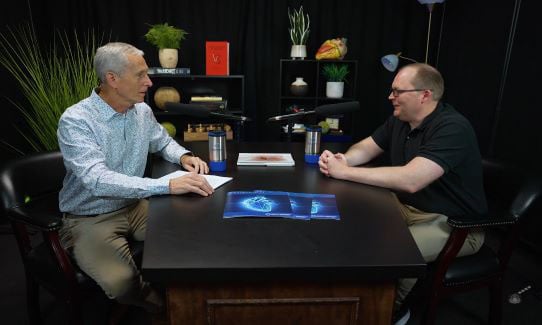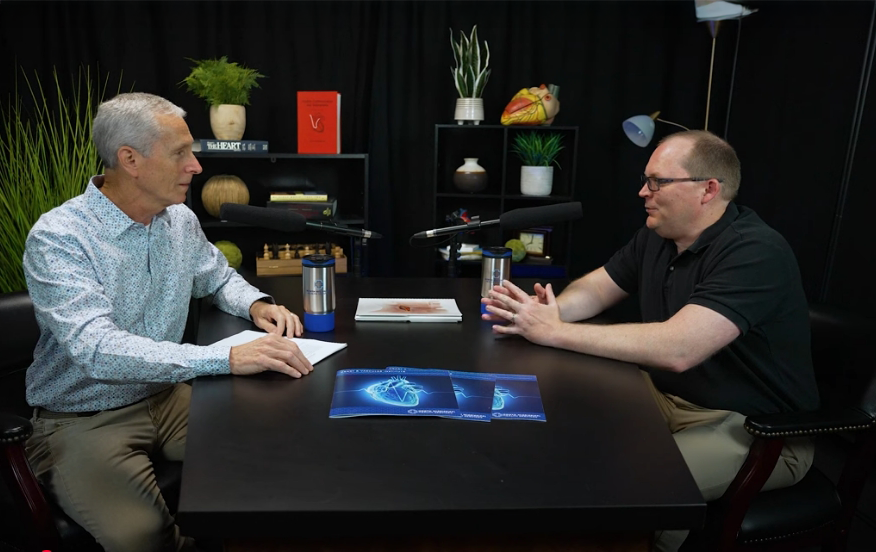



Summary
In this episode of We’re All Heart, Dr. Barry Bertolet talks with vascular surgeon Dr. Joey Stinson. From early detection with ultrasound to advanced treatments like TCAR, they explore how modern vascular care is transforming stroke prevention.
We're All Heart: Episode Two

Podcast Transcript
Introduction: Life is about the moments that make your heart tick, and we’re here to keep it ticking strong. I’m Dr. Barry Bertolet, and this is We're All Heart, where we dive into the latest cardiac care with the experts who live it every day.
From breakthrough procedures to the most cutting-edge treatments, we're putting heart health front and center.
We're All Heart is brought to you by North Mississippi Health Services in partnership with Cardiology Associates of North Mississippi. Let's get to it.
Dr. Barry Bertolet: Hi there. Welcome to another edition of We’re All Heart, and today we're joined by Dr. Joey Stinson, who's a vascular surgeon at North Mississippi Medical Center. Welcome Joey.
Dr. Joey Stinson: Thanks for having me.
Dr. Bertolet: Yeah, absolutely. Tell the audience a little bit about who you are, your education and what practice do you do here at North Miss.
Dr. Stinson: Okay. So like Dr. Bertolet said, I’m a vascular surgeon, which is a surgeon who's completed specialty training in vascular disease, which is mainly arteries and veins - beyond general surgery, which is five years of training, an additional two years is vascular surgery. I've been here in Tupelo for 10 years next month. And my practice mainly consists of carotid disease, which we'll discuss today, and peripheral arterial disease and aneurysmal disease.
Dr. Bertolet: So that's a quite a specialty then. So how many vascular surgeons are even in north Mississippi?
Dr. Stinson: So there's only me and my partner here at North Mississippi Medical Center that are the only full-time board certified vascular surgeons in north Mississippi. The other ones are in Jackson. And then you have to go to Memphis or UAB to find another vascular surgeon. (Continued below)

We're All Heart
Join Dr. Bertolet for more episodes featuring local experts in all areas of heart health. We'll learn about the cutting-edge treatments offered right here in north Mississippi - often before the rest of the state or even nation. New episodes drop on YouTube or anywhere you get your podcasts every other week.

We're All Heart
Join Dr. Bertolet for more episodes featuring local experts in all areas of heart health. We'll learn about the cutting-edge treatments offered right here in north Mississippi - often before the rest of the state or even nation. New episodes drop on YouTube or anywhere you get your podcasts every other week.
Dr. Bertolet: So, I mean, just to reiterate what you just said, so if I had a blockage in my neck or if I had an aortic aneurysm or problems in my legs, if I wanted to have a true specialist dedicated to those areas, I would need to come to you.
Dr. Stinson: That's right. Or you'd have to drive several hours.
Dr. Bertolet: Right. Well, so that, that's important I think for us to all know about. That's, that's quite impressive there. So you mentioned today we're talking about carotid disease and the carotid arteries. They are the blood vessels that feed your brain. And so they're sort of important to know about those and make sure that they're open.
And so if you don't have good blood flow to your brain, then that can cause strokes, that can cause dementia, that can cause memory issues that can cause you to pass out. And so sometimes those get to be important symptoms that can occur. So talking about the carotid arteries, tell me a little bit about the carotid arteries and why do people develop blockage there?
Dr. Stinson: So I think the best thing to show you on this diagram here, so the carotid arteries is actually three blood vessels, but generally when people are discussing a carotid artery disease from a clinical aspect, they're talking about the internal carotid artery.
So you have the common carotid artery that comes up out of the chest and then it branches and the internal goes into the brain and the external goes into the face. So the bowl, but the branch point and the proximal portion of the internal carotid artery is where disease tends to occur.
The reason that that occurs at that point is the bifurcation. So as a stream or anything in nature, anytime there's a branch point when fluid, whether that's water or blood, there tends to be sediment form at that branch point. And that sediment, when we're talking about the internal carotid artery, blood vessel to the brain, can narrow the flow into the brain. So that can cause a stroke or stroke-like symptoms in addition, pieces of that can break loose and go downstream and lodge in vessels in the brain, which also can cause strokes.
Dr. Bertolet: So what would be risk factors that someone might have that would cause that sediment like cholesterol, blood pressure or those kind of things?
Dr. Stinson: Yeah, so the general cardiovascular risk factors, high blood pressure, cholesterol, diabetes, smoking, tobacco use is one of the, the big risk factors.
Dr. Bertolet: And if you control those risk factors, if you have them or try to avoid them - not smoking - does that help prevent the buildup of that plaque, that sediment, as you mentioned?
Dr. Stinson: It can. There's always a genetic factor and some people that try to do everything they can, are still gonna develop it.
One of the big, big things I want to get across is you cannot undo the what's already there, but you may prevent it from worsening.
There's no, as of to date, there's no medication that can dissolve plaque once it's formed. But it can be things like statin medications can stabilize plaque that's already there, and if you avoid smoking and things like that, you maybe prevent it from getting worse.
Dr. Bertolet: How do people find out that they even have a blockage in their neck? What would be a way that the audience could find out if they have some kind of sediment buildup?
Dr. Stinson: Yeah, it'd be very important to, and a very easy way of doing that is a carotid ultrasound, which is a non-invasive test that can be done in a clinic.
Our clinic, your clinic, they just run a probe on the outside of your skin and look at that branch point and you can measure the flow through that area and determine how much blockage is in that area. Unfortunately, we still have a lot of people who don't know that and they, first time we see it is either they've had a stroke or a mini stroke, but it's a very simple test that could be done in an office or outpatient setting.
Dr. Bertolet: And you mentioned earlier about if you have this plaque that you may not can make it go away, what are steps that somebody could take to keep it from getting worse? So let's say I find out I got a 50% blockage in my neck artery. What can I do to keep that from getting worse?
Dr. Stinson: Yeah, so if you have high blood pressure, then keeping less than 120 over 80, controlling your cholesterol, LDL, which is a bad cholesterol, less than 100 unless you have cardiac disease, then less than 70, controlling diabetes, cessation of all tobacco products, particularly smoking, healthy lifestyle, exercise, eating healthy, those are the type things to do.
Dr. Bertolet: So let's say that we did that ultrasound and, and now I have a 70% blockage in that neck artery there, or an 80% blockage. What's the point at which we are maybe beyond where medical therapy could help or stabilize? Where would I need your services?
Dr. Stinson: Yeah. So anything less than 50% would be considered normal.
So no intervention is needed at that point. And then you have a moderate range of blockage, which is a 50 to 69 range on ultrasound. And that's generally medical management as well. Unless you develop symptoms such as TIA or mini strokes, or full-blown strokes. Generally that range, you don't need therapy unless you have symptoms. But once you get greater than 70, particularly 80% narrowed now, your risk of stroke substantially increases.
It would be recommended to have some type of a procedure to lower your risk of a stroke, particularly if, you know, if you have at least a five year life expectancy.
Because the point is, is you want to have a good quality of life and a stroke can certainly dampen that. So greater than 70 is generally when we would start talking about treatment options, invasive treatment options.
Dr. Bertolet: So symptoms might be, you mentioned a stroke, you me mentioned a mini stroke - a TIA - what other symptoms would somebody have if they had a problem with their neck blood vessel?
Dr. Stinson: So your brain, it's weird. Your left side of your brain controls the right side of your body generally. So if you have a problem with your left carotid, then you may develop, numbness or weakness of your right arm or your right leg.
Also left side, you may have difficulty forming words, you may know what you want to get out and say, but you can't get the words out or the other extreme, you may be able to talk, but it's garbled and doesn't make any sense.
Also drooping of your face. Some dysphagia can also, which is difficulty swallowing, um, long-term ischemia, which is decreased blood flow to your brain can lead to, vascular dementia, forgetfulness, things like that.
Dr. Bertolet: And then what are the surgical options if someone were to have a bad blockage and need to get that fixed?
Dr. Stinson: Yeah, so the traditional way is what's called a carotid endarterectomy, which is a surgery. You make an incision underneath your jaw bone at the angle of the jaw, and you actually remove the plaque inside the artery. Then when you're finished, you close that up with a patch. So now the artery's nice and wide open and all that sediment I mentioned earlier has been removed.
So that's a traditional way that's been going on since the 1950s. Very good option. And still the preferred option if, if possible.
The other option is stenting. Um, and there's two methods of stenting. So if stent goes inside the artery doesn't remove the plaque, but you go inside under, X-ray and you deploy on the inside. So what this does, it opens up and acts as scaffold, so it pushes the plaque to the side, so it traps it, so it opens the vessel up, but it also would prevent anything from breaking loose and going downstream and causing the stroke. Like I mentioned earlier, um, the trans carotid, the TCAR here is the more modern way of doing it, which has been widely practiced since since 2019.
But prior to that, there was transfemoral, which we'd go through your groin artery like you would with having a heart cath or leg catheter. We still do that occasionally - this is more favored than that currently.
Dr. Bertolet: So you mentioned that TCAR procedure, I want to get into that in a minute, but who all in north Mississippi does the TCAR procedure?
Dr. Stinson: So our hospital – so me and my partner Dr. Sachdev, one of the cardiac surgeons with us, do that procedure.
Dr. Bertolet: So just two in the entirety of the north part of the state. Amazing.
And so this is a new newer procedure. You mentioned, you know, maybe five, six years old, so it's got some legs behind it. Tell me a little bit about that procedure. How is it done?
How invasive is that as compared to maybe a traditional surgery?
Dr. Stinson: So it is definitely less invasive than traditional surgery. It still requires an incision on the neck. However, instead of the incision being up and down under your ear, it's actually down at the collarbone. You are asleep for this just like the surgery. So you're not having to remember or feel this, but the incision is probably half the length of the traditional surgery.
There's also a catheter placed in one of your veins in the groin. I'll tell you why in a second. But the stent is actually placed through that incision above your collarbone. You place this, the sheath in here, which is how we deliver the stent, and then the catheter that's in the vein creates this circuit. So the real unique part of this TCAR procedure is what's called a flow reversal.
So when you hook the circuit up, blood sucked out from down the brain goes through this filter outside the body, which collects any type of sediment that might, would traditionally have went downstream into the brain, and then the blood goes through and the blood goes back into your vein.
So it creates this nice circuit. That was the problem with traditional stenting was you place a stent, but you knock something loose and you cause a stroke. So the stroke rate for a stent was actually double the stroke rate for traditional surgery. With this new method, the stroke rate's equivalent to the open surgery. And then you, of course you remove all this once you’ve placed the stent and restore blood flow in the normal antegrade path.
Dr. Bertolet: So you're actually reversing flow.
So you're taking flow down the carotid artery instead of the blood flow in naturally up to the brain, you're reversing it and then you're filtering that blood and then giving it back to the person so it doesn't have the sediment in it.
So when you're reversing that blood flow, how is the brain protected?
Dr. Stinson: So it's protected because well you have to look at the other side.
So there's some limitations to this procedure. But so if the other side's open, which means less than 50% without symptoms, you're providing blood flow from the other side. Let's say we're working on the right side, the left side
of the carotid is now supplying blood to the entire brain. And again, we're not talking about a long period of time, we're talking about five to six minutes of flow reversal. So that is something you have to look at and that's why not everybody would be a candidate for this. And that's why it's important to find a doctor that does perform both procedures so they can tell you the limitations and advantages of each type of procedure.
Dr. Bertolet: Wow. So it's pretty amazing that that technology is available here. So as we sort of wrap up, one of the things that we've been talking about is our true north. And when you've talked about coming here being one of the only one of the two vascular surgeons in this region, what brought you here?
What is your drive? What's your true north in bringing advanced vascular care to north Mississippi?
Dr. Stinson: Yeah, I think that was exactly it. I wanted to come to a place that was in need of modern vascular care without having to make patients drive for hours to receive the care that we can provide here. So I think that's my main goal was to increase the quality vascular care in a rural area.
Dr. Bertolet: And if people wanted to reach out to you to schedule a consultation, that number is now provided at the bottom of the screen. As well as our website is connected here.
So Dr. Stinson, I thank you so much for taking time today. I thank you for what you do for the citizens of north Mississippi.It's absolutely amazing. So thank you for being here.
Dr. Stinson: Thank You for having me.


Joey Stinson, MD
Dr. Joey Stinson is a vascular surgeon with Cardiothoracic and Vascular Surgery Clinic. A native of Opelika, Alabama, Dr. Stinson relocated to Tupelo for an opportunity to build a top-notch vascular program in 2015, shortly after completing a vascular surgery fellowship at the University of Mississippi Medical Center in Jackson. He has a special interest in carotid disease, abdominal aortic aneurysmal disease and peripheral vascular disease.
If you're over 35, schedule a heart screening to identify your risk of heart disease. Request an appointment online or call 1-800-THE DESK (1-800-843-3375).

Subscribe to Our Newsletter
Like this content and want to get more? Sign up for True North, the health and wellness newsletter from North Mississippi Health Services!

Subscribe to Our Newsletter
Like this content and want to get more? Sign up for True North, the health and wellness newsletter from North Mississippi Health Services!

Nurse Link®
Not sure if you need Urgent Care or the ER? Call 1-800-882-6274 anytime to speak directly to a registered nurse and get immediate answers. Using computerized medical protocols, nurses direct callers to the most appropriate treatment. Our nurses are available 24 hours per day, seven days per week.